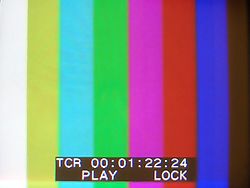
Vertical Interval Timecode is a form of SMPTE timecode encoded on one scan line in a video signal. These lines are typically inserted into the vertical blanking interval of the video signal.
Audio Video Interleave is a proprietary multimedia container format and Windows standard introduced by Microsoft in November 1992 as part of its Video for Windows software. AVI files can contain both audio and video data in a file container that allows synchronous audio-with-video playback. Like the DVD video format, AVI files support multiple streaming audio and video, although these features are seldom used.

DV is a family of codecs and tape formats used for storing digital video, launched in 1995 by a consortium of video camera manufacturers led by Sony and Panasonic. It includes the recording or cassette formats DV, MiniDV, DVCAM, Digital8, HDV, DVCPro, DVCPro50 and DVCProHD. DV has been used primarily for video recording with camcorders in the amateur and professional sectors.
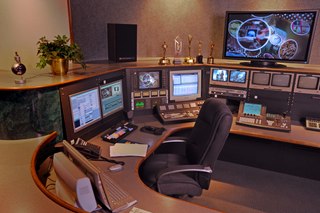
Non-linear editing is a form of offline editing for audio, video, and image editing. In offline editing, the original content is not modified in the course of editing. In non-linear editing, edits are specified and modified by specialized software. A pointer-based playlist, effectively an edit decision list (EDL), for video and audio, or a directed acyclic graph for still images, is used to keep track of edits. Each time the edited audio, video, or image is rendered, played back, or accessed, it is reconstructed from the original source and the specified editing steps. Although this process is more computationally intensive than directly modifying the original content, changing the edits themselves can be almost instantaneous, and it prevents further generation loss as the audio, video, or image is edited.
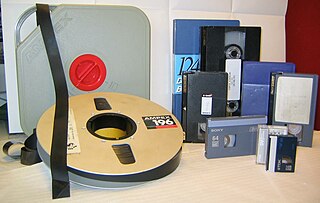
Videotape is magnetic tape used for storing video and usually sound in addition. Information stored can be in the form of either an analog or digital signal. Videotape is used in both video tape recorders (VTRs) and, more commonly, videocassette recorders (VCRs) and camcorders. Videotapes have also been used for storing scientific or medical data, such as the data produced by an electrocardiogram.
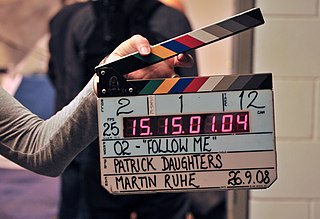
SMPTE timecode is a set of cooperating standards to label individual frames of video or film with a timecode. The system is defined by the Society of Motion Picture and Television Engineers in the SMPTE 12M specification. SMPTE revised the standard in 2008, turning it into a two-part document: SMPTE 12M-1 and SMPTE 12M-2, including new explanations and clarifications.

A camcorder is a self-contained portable electronic device with video and recording as its primary function. It is typically equipped with an articulating screen mounted on the left side, a belt to facilitate holding on the right side, hot-swappable battery facing towards the user, hot-swappable recording media, and an internally contained quiet optical zoom lens.
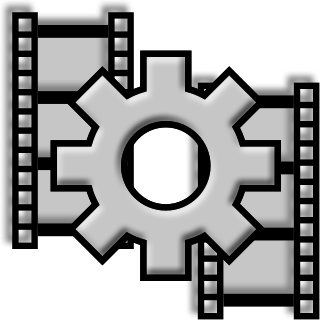
VirtualDub is a free and open-source video capture and video processing utility for Microsoft Windows written by Avery Lee. It is designed to process linear video streams, including filtering and recompression. It uses AVI container format to store captured video. The first version of VirtualDub, written for Windows 95, to be released on SourceForge was uploaded on August 20, 2000.
An edit decision list or EDL is used in the post-production process of film editing and video editing. The list contains an ordered list of reel and timecode data representing where each video clip can be obtained in order to conform the final cut.

A waveform monitor is a special type of oscilloscope used in television production applications. It is typically used to measure and display the level, or voltage, of a video signal with respect to time.
In video technology, 24p refers to a video format that operates at 24 frames per second frame rate with progressive scanning. Originally, 24p was used in the non-linear editing of film-originated material. Today, 24p formats are being increasingly used for aesthetic reasons in image acquisition, delivering film-like motion characteristics. Some vendors advertise 24p products as a cheaper alternative to film acquisition.

The 8mm video format refers informally to three related videocassette formats. These are the original Video8 format and its improved successor Hi8, as well as a more recent digital recording format known as Digital8. Their user base consisted mainly of amateur camcorder users, although they also saw important use in the professional television production field.

HDV is a format for recording of high-definition video on DV videocassette tape. The format was originally developed by JVC and supported by Sony, Canon, and Sharp. The four companies formed the HDV Consortium in September 2003.

D-VHS is a digital video recording format developed by JVC, in collaboration with Hitachi, Matsushita, and Philips. The "D" in D-VHS originally stood for "Data", but JVC renamed the format as "Digital VHS". Released in December 1997, it uses the same physical cassette format and recording mechanism as S-VHS, but requires higher-quality and more expensive tapes and is capable of recording and displaying both standard-definition and high-definition content. The content data format is in MPEG transport stream, the same data format used for most digital television applications. It used MPEG-2 encoding and was standarized as IEC 60774-5.

Windows Movie Maker is a discontinued video editing software program by Microsoft. It was first included in Windows Me on September 14, 2000, and in Windows XP on October 25, 2001. It later became a part of the Windows Essentials software suite, and offered the ability to create and edit videos as well as to publish them on OneDrive, Facebook, Vimeo, YouTube, Windows Live Groups, and Flickr. It is comparable to Apple's iMovie.
Offline editing is the creative storytelling stage of film making and television production where the structure, mood, pacing and story of the final show are defined. Many versions and revisions are presented and considered at this stage until the edit gets to a stage known as picture lock. This is when the process then moves on to the next stages of post production known as online editing, colour grading and audio mixing.
Control track longitudinal timecode, or CTL timecode, developed by JVC in the early 1990s, is a unique technique for embedding, or striping, reference SMPTE timecode onto a videotape.
Camtasia is a software suite, created and published by TechSmith, for creating and recording video tutorials and presentations via screencast, or via a direct recording plug-in to Microsoft PowerPoint. Other multimedia recordings may be recorded at the same time or added separately. Camtasia is available in English, French, German, Japanese, Portuguese, Spanish and Chinese versions.
Ingex is an open-source (GPL) suite of software for the digital capture of audio and video data, without the need for traditional audio or video tape or cassettes. Serial digital interface (SDI) capture is supported, as well as real-time transcoding. Portions of the software suite also act as a network file server for media files, as well as archiving to LTO-3 data tape. Audio and video media files can also be stored on USB hard drives or Network Attached Storage. The software is heavily used by the BBC, and was developed by the BBC Research Laboratory.

AVS Video Editor is a video editing software published by Online Media Technologies Ltd. It is a part of AVS4YOU software suite which includes video, audio, image editing and conversion, disc editing and burning, document conversion and registry cleaner programs. It offers the opportunity to create and edit videos with a vast variety of video and audio effects, text and transitions; capture video from screen, web or DV cameras and VHS tape; record voice; create menus for discs, as well as to save them to plenty of video file formats, burn to discs or publish on Facebook, YouTube, Flickr, etc.
